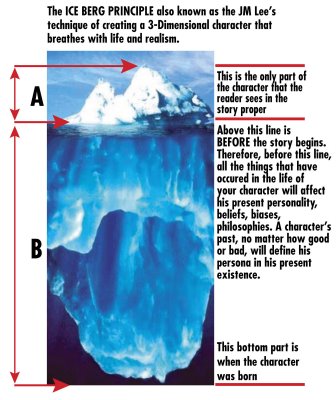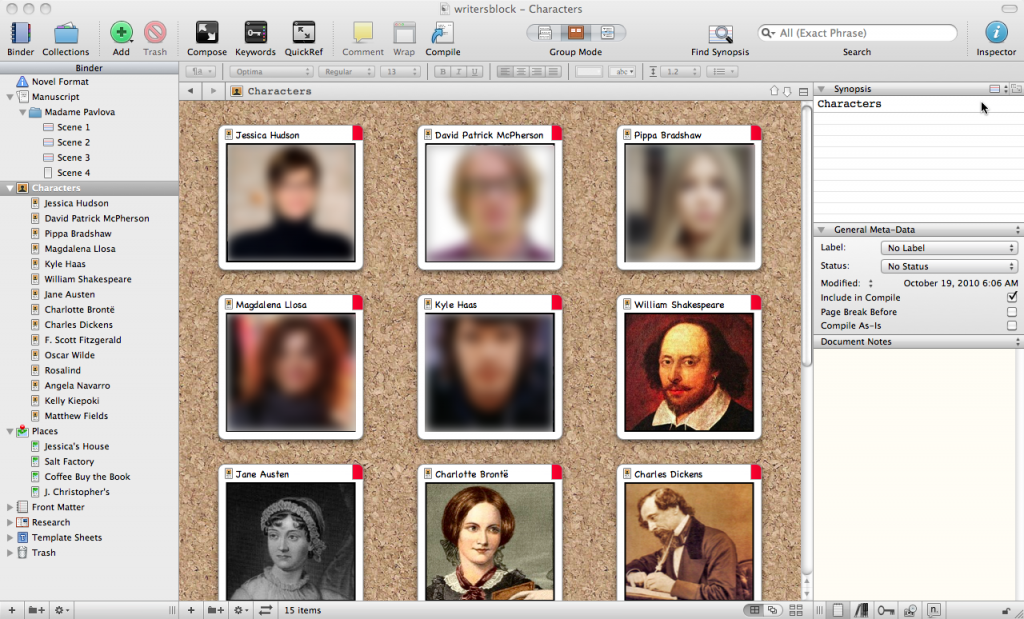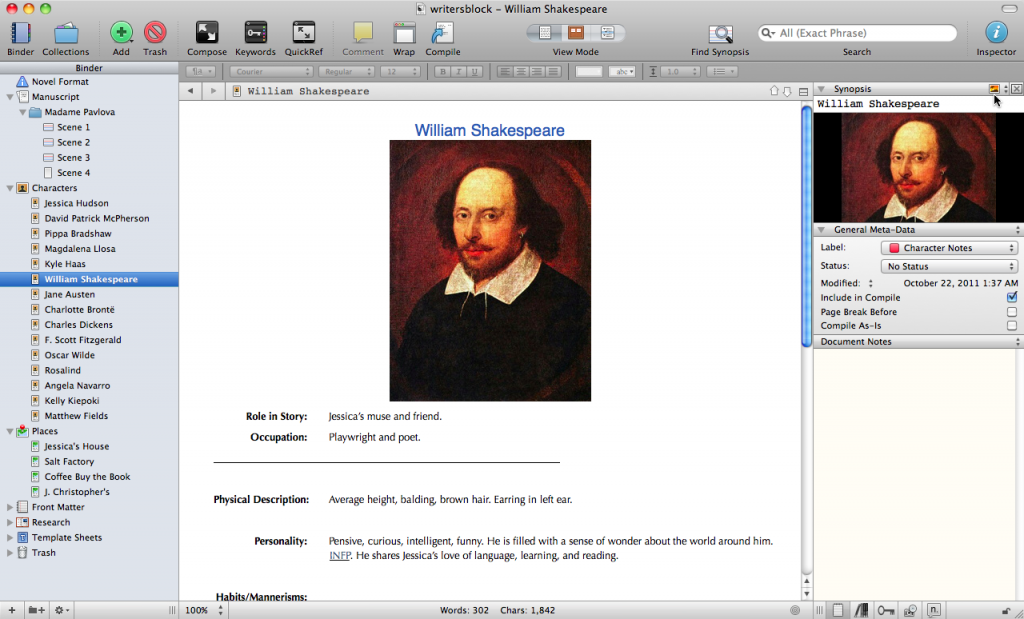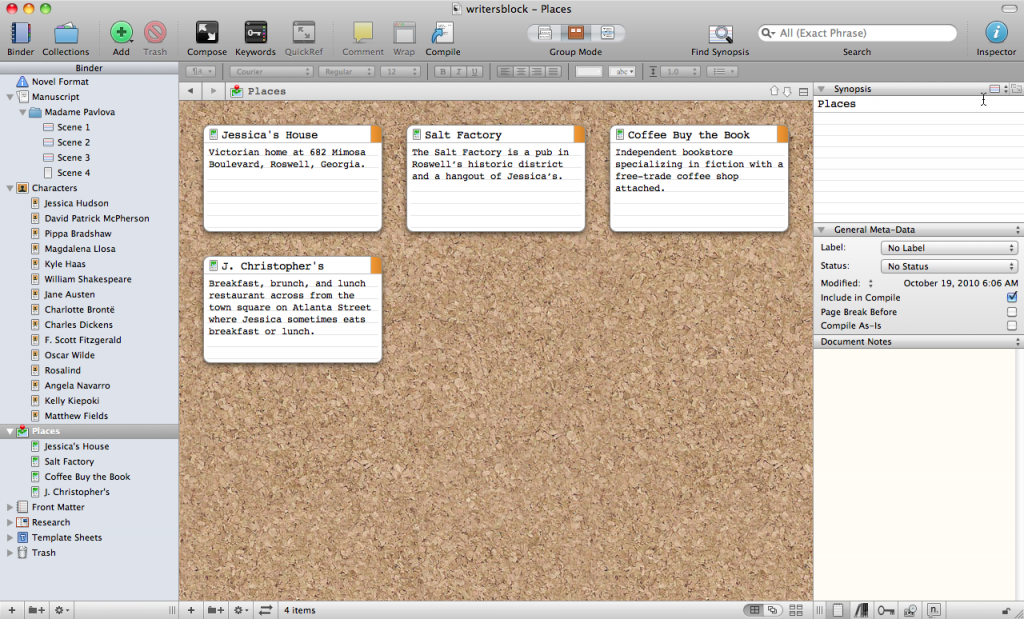I literally went from slightly worried about whether I should participate in NaNoWriMo this year because I didn’t have an idea to wildly excited about my idea in the space of time it took me to write my last blog post.
I really love participating in NaNoWriMo because the sense of camaraderie I feel as I am tackling the same sort of project, which is usually, admittedly, quite a solitary experience, that so many others are currently tackling, which gives me a sort of encouragement that writing on my own doesn’t. My husband says he’s going to participate this year, which is exciting.
I have spent most of today and yesterday creating character and scene notes in Scrivener. If you’re not familiar with the software and you are thinking of doing NaNoWriMo this year, you should check it out. In case you are interested enough to buy, be aware that Scrivener does a NaNoWriMo deal. You can download an extended trial version of the software, and if you “win” NaNoWriMo (write 50,000 words), you will receive a coupon for 50% off the software. I unfortunately won’t be able to take advantage of this deal because I downloaded the trial too early. On November 1, however, I can buy the software for a 20% discount. I like it enough that I think I will, especially because I do a lot of serious writing, and Scrivener is great for planning writing. I did not have this software last year, and it would have been helpful.
What I like about the character and setting notes templates is the ability to organize my characters on a corkboard and use images. I hesitated over whether to share a screencap of my work in progress because I use the images of some fairly famous folks as inspiration, and I do not necessarily want readers to figure out who, so I have doctored the photo a bit, but this is what my character notes corkboard looks like (click to see a larger version):
When you click on one of the character cards, you see my notes about each character. I’ll pick Shakespeare so I don’t have to blur the images (click to enlarge):
The character templates have premade sections to create notes on the character’s role in the story, occupation, physical description, personality, habits/mannerisms, background, internal conflicts, external conflicts, and general notes.
In addition, it has a name generator that I found very handy for coming up with character names, though I didn’t use it for all the characters I created.
I’m taking the dictum “write what you know” to heart and setting my NaNo novel in my own neighborhood. I can tell you’ve I’ve already gone on research treks twice, and it’s been beneficial to live in the midst of the places I’m using as settings. Here is a glance at my setting corkboard (click to enlarge):
I have really enjoyed the planning part of this novel (perfectly permitted before November 1), and I feel already as though I know the characters. The templates are useful guides for creating characters, even if I do not use the material I write later in the novel. Hemingway once compared writing to an iceberg, and he said that the part we see above the water is just the smallest part of what the writer actually knows.
If a writer of prose knows enough of what he is writing about he may omit things that he knows and the reader, if the writer is writing truly enough, will have a feeling of those things as strongly as though the writer had stated them. The dignity of movement of an ice-berg is due to only one-eighth of it being above water. A writer who omits things because he does not know them only makes hollow places in his writing. (Death in the Afternoon)
Here’s an image that demonstrates the Iceberg Principle:

Image via Pinoy·Comics·TV·Movies
I do not claim to be mapping out my characters’ entire lives, but I am including details in my notes that I doubt will make it into my story. I also figured out, for whatever it’s worth, each of my characters’ Myers-Briggs types. That actually turned out to be a good exercise in getting to know the characters because making them adhere to a type formed a great deal of their personality and made them more real to me.
Some of the most fun I’ve had has been creating my dream home as a setting and giving it to my protagonist. I must admit I’ve absolutely fallen in love with her house, and I hope I can recreate it on paper.
I also began making an outline for events, but I didn’t do too much with the outline yet.
I very rarely gush about software, and I promise they aren’t paying me, but I am in love with Scrivener. I know that technically speaking I could plan the same way, but Scrivener pulls my plan together with my actual manuscript in a way that makes it easy for me to keep track of everything because it’s all in one place, and has a beautiful, intuitive interface.
photo credit: Nicole April




You'll do great! I'm prepping myself for NANO. I'm really determined to get finish this year..even if its going to be a really really rough draft.
Thanks so much for the encouragement, Natasha! Much appreciated.
You’ll do great! I’m prepping myself for NANO. I’m really determined to get finish this year..even if its going to be a really really rough draft.
Thanks for this! I just downloaded the software and started using it a few hours ago. It's helpful to see what other people have done.
I will definitely have to try the name generator because I am TERRIBLE at making up names.
Great, Brittany! The name generator is great. I used it for the names of my protagonist and several other characters, but the rest I tweaked, using the name generator for some general ideas.
Nice write-up. I hadn't seen the Character and Setting templates before (I'm using the paid version of Scrivener), but now I've downloaded the NaNo 2011 template to use next month.
I really like the idea of completing personality profiling like Myers-Briggs for characters too, especially coupled with one of those guides that explain how each personality type will behave in situations – I can see how that would make it easier to predict how your characters will react to events in the novel.
Thanks, Matthew! I didn't realize there was a NaNo template. I guess I didn't read all of that page I linked to! I downloaded it, but since I don't know of a way to convert from one template to another after you've already started a project, I just started a new one and dragged over the templates for daily word count and the compile for NaNoWriMo. I think I can just set the target word count myself. Thanks for the heads up!
Hi, the special offer of scrivener should work even if you have installed another trial version. Just delete the older trial version and install the nanowrimo-trial.
I thought about trying that, but I worried I'd lose my previous projects or that they wouldn't work.
Updating or trashing the application won't affect your projects. It's like creating a document with Word and then delting MS Office from the computer–all your .docx files are still on your drive. Scrivener projects are saved with a .scriv extension, so if you don't remember where you created a project, you can usually find it pretty easily by looking for ".scriv" in Spotlight.
So feel free to install the NaNo trial and use that for November if you want to hold off on purchasing until you've got that 50% coupon!
Jennifer, that's great news! For any readers who happen by, Jennifer is an employee of Literature and Latte, the company that produces Scrivener. I am going to do this because I have a feeling this year I could be lucky.
Great post. I am entering NaNo for the very first time this year and have just downloaded the Scrivener trial. Like you I have been using the character and setting folders with great success, although being a complete technophobe it took a while to figure it out and I seem to have accidentally deleted character templates! Previously I have had various notebooks scattered around and this is much better. Scrivener is brilliant and I will definitely buy the full version when available. Good luck with NaNo. I'm sure you'll do brilliantly!
Thanks Sharon! Good luck to you, too! I think you can get those templates back. Their tech support could probably help you.
This will be my first NaNo, and I'm really excited. I'm using the paid version of Scrivener, and I love how it keeps everything organized. I've written an outline totaling over 11,000 words, so I hope this will help me reach the 50,000 word goal for my first draft. I haven't yet used the character templates because I'm bad at creating original characters, but you've gotten me all excited now and I plan on using them soon. Thanks for the great post, and good luck on your novel for NaNo!
Good luck to you, too, Maria. The character templates are really helpful.
I've been using Scrivener for a while now and I love it. I got it with the NaNo discount, but knowing what I do now, I would pay full price for it without blinking an eye. It's worth every penny.
I agree! But if I can get a deal on it, even better!